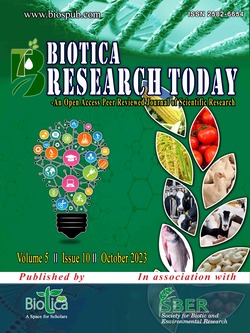
Microgreens: The Treasure Trove of Nutrients
Prasoon Gunjan
Division of Food Science and Postharvest Technology, ICAR-Indian Agricultural Research Institute, New Delhi (110 012), India
Pooja B.K.
Division of Food Science and Postharvest Technology, ICAR-Indian Agricultural Research Institute, New Delhi (110 012), India
Shruti Sethi*
Division of Food Science and Postharvest Technology, ICAR-Indian Agricultural Research Institute, New Delhi (110 012), India
Brijesh Kumar Yadav
Division of Food Science and Postharvest Technology, ICAR-Indian Agricultural Research Institute, New Delhi (110 012), India
DOI: NIL
Keywords: DIHAR, Leafy vegetables, Microgreens, Phytochemicals
Abstract
Microgreens, often referred to as "vegetable confetti," have emerged as a nutritional treasure trove in the modern quest. These tiny, vibrant greens, harvested just 7 to 21 days after sowing, offer a powerhouse of nutrients, often surpassing their mature counterparts. Originally developed in San Francisco in the late 1980s, microgreens widely recognized for their exceptional nutritional value and sensory qualities, making them a superfood of choice. This article explores the production of microgreens from plants, including herbs, vegetables and grains. Microgreens are rich in vitamins, minerals, phenolics and flavonoids, with potential health benefits, such as reducing the risk of Alzheimer's disease, diabetes, heart disease and certain cancers due to their antioxidant-rich nature. Practical application of microgreens extends to Indian army, which uses them in challenging high-altitude environments for essential nutrition. In a world overwhelmed with dietary choices, microgreens offer a simple, accessible and profoundly nutritious solution.
Downloads
not found
Reference
Ghoora, M.D., Haldipur, A.C., Srividya, N., 2020. Comparative evaluation of phytochemical content, antioxidant capacities and overall antioxidant potential of select culinary microgreens. Journal of Agriculture and Food Research 2, 100046. DOI: https://doi.org/10.1016/j.jafr.2020.100046.
Pinto, E., Almeida, A.A., Aguiar, A.A., Ferreira, I.M.P.L.V.O., 2015. Comparison between the mineral profile and nitrate content of microgreens and mature lettuce. Journal of Food Composition and Analysis 37, 38-43. DOI: https://doi.org/10.1016/j.jfca.2014.06.018.
Singh, N., Aditika, Rani, S., Chaurasia, O.P., 2020. Vegetable microgreens farming in high-altitude region of trans-himalayas to maintain nutritional diet of Indian troops. Proceedings of the National Academy of Sciences, India Section B: Biological Sciences 90, 743-752. DOI: https://doi.org/10.1007/s40011-019-01147-0.
Weber, C.F., 2016. Nutrient content of cabbage and lettuce microgreens grown on vermicompost and hydroponic growing pads. Journal of Horticulture 3(4), 1000190. DOI: https://doi.org/10.4172/2376-0354.1000190.
Xiao, Z., Codling, E.E., Luo, Y., Nou, X., Lester, G.E., Wang, Q., 2016. Microgreens of Brassicaceae: Mineral composition and content of 30 varieties. Journal of Food Composition and Analysis 49, 87-93. DOI: https://doi.org/10.1016/j.jfca.2016.04.006.
